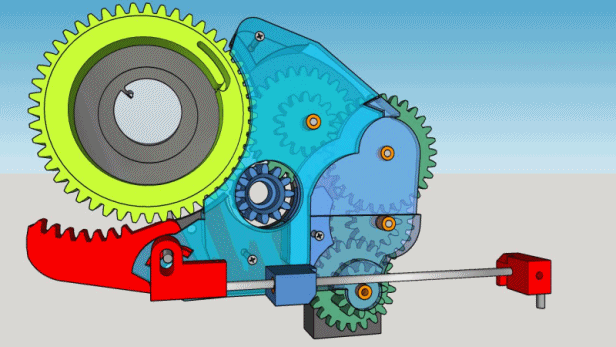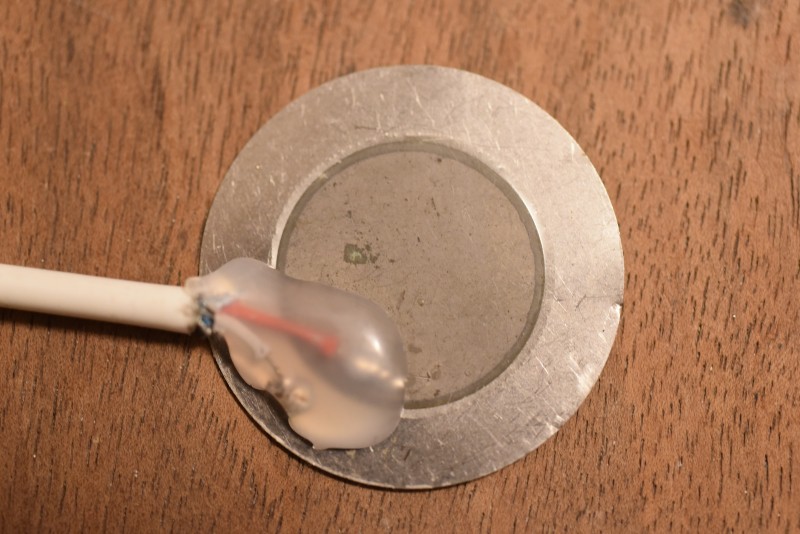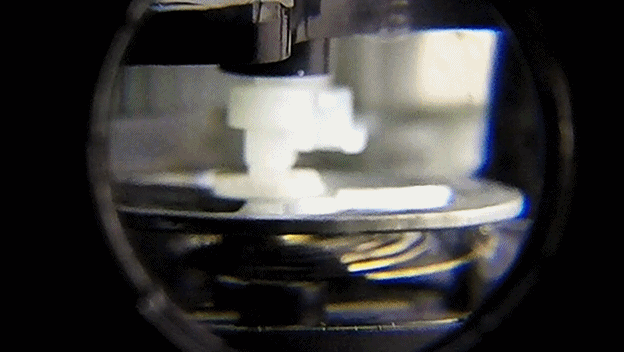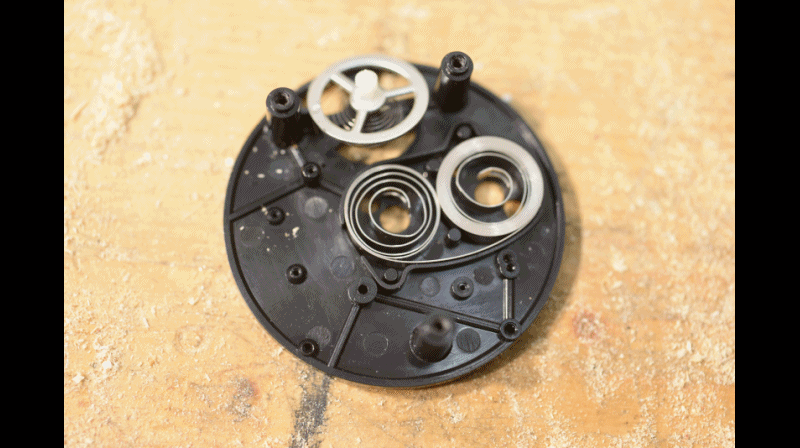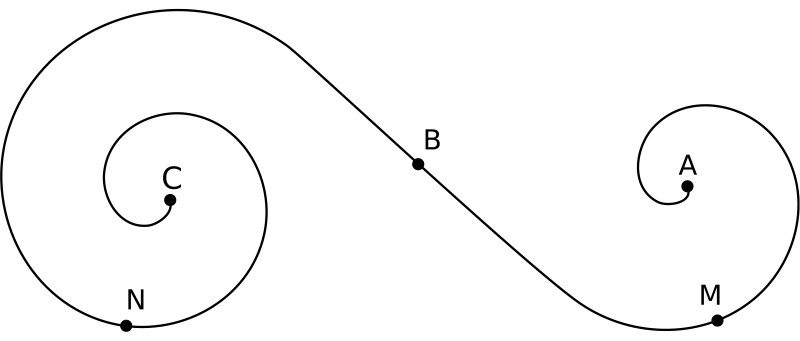-
11. timer, again.
09/19/2018 at 09:29 • 1 commentSeptember 16, 2018
Since the beginning of this project, I have had reliability problems with the kitchen timer. Sometimes it ran 7 hours without a problem, sometimes it stopped mysteriously after only 20 minutes.
as if by coincidence, there are problems with the only mechanism that it was not me who did it. I'm not criticizing, but I take note.
In reality, it's pretty normal that it does not work well, because I use it largely outside of its specifications. There is a big difference between turning a small dial in the air for an hour and moving gears and springs for 5 hours.I am not going to list all that I tried to solve this problem but you have to know that I screwed up around fifteen timers while looking in the wrong direction.
![]()
For example this thing with mad eyes, you will be nice not to ask me what it is, I don't want to talk about it.
At this point I do not know what to do, so to pass the time we will play doctor.
I made a stethoscope with an old piezo buzzer:
It is practically insensitive to the vibrations of the air but very sensitive to the vibrations of a solid.
In addition, I think it is a little directional given its flattened shape, which should allows to focus on an axis.Logically, the amplitude of the noise of the ticking should correspond to the force exerted on the pendulum and I will perhaps finally be able to find where it gets hot.
![]()
It's not "haute horlogerie", it's made for cooking.
For an unmodified timer, we get this:
![]()
To increase the power reserve, I unrolled the spring in double spiral to make one, I put it on the back of the timer and attached it to the axis of the clutch (there is not enough room inside for the complete spiral). The ferrule is taken on another clutch, I do not lack spare parts.
![]()
Yes, I know it's not good to tinker with small mechanisms in sawdust, but it's so much warmer.
When the timer does not stop in it's way, we get this:![]()
It's noticeably less clean and there are weird peaks from time to time![]()
Zooming again, we notice that these peaks have a different spectrum and are not synchronous with the ticks, whose amplitude increases just after.
![]()
So it's not rubbing, it's more like slipping.
the timelapse allows to see the phenomenon, although it is discreet, actually the spring does not move fluidly but rather by small jerks. It does not slide very well on itself, contrary to foolishness.
Listening is clearer:
If we look at the distribution of tick-tac amplitudes, we see that the standard timer has almost a Gauss curve
![]()
while mine has several bumps.
![]()
Here it is very clear, the bumps on the left represent the slowdowns before the strike-slips.
In fact I have no idea, but I'm pretending because it would suit me well.
I think it's a bit like an hourglass: there are lots of small collapses and occasionally, an unpredictable avalanche. My problem is when nothing moves before the avalanche.I tried to polish the spring with emery paste, grease it and everything, but there is nothing to do.
We are in trouble, I think that maybe it was not so smart to build an automaton around a kitchen utensil, and maybe I should accept once and for all that We rarely do a nice thing from a stupid idea.
OK, I did not want to get there but since that's it, we're going to read a little theory about spiral springs.
The spiral is a long steel blade wound on itself.
As the turns do not touch, the force applied to one end of the spring is distributed over its entire length, which allows to have a very long range of elasticity in reduced dimensions. We have a good usable portion with almost constant force.
I dumbly thought that to make a spiral spring it was enough to wrap it around an axis, well no, we must first give the double spiral this confusing S shape.
![]()
This is the only way to prevent the turns from touching each other.![]()
Preforming the spring is a little more hardcore than it looks, the people still able to do it properly are counted on the fingers of the hand of a carpenter, the others are missing since the years eighty.I have an idea: What if I replaced my foolish spring with TWO foolish springs?
By fixing them on the same axis, knowing that the blockages are random, there is little chance that a critical slowdown will occur at the same time on both, and logically the moments of weakness of one should be offset by the other.So I put the original spring inside, keeping the other one on the outside.
The movable arm, I added it to prevent the curvature of the first portion of the spring from changing,
![]()
I think it is useless except it foolishly decenters the spiral, but it works so we will stop touching everything.The recording is much cleaner
![]()
And the distribution almost normal.![]()
isn't it beautiful life?
I add that ticking is also part of the specs for a timer, we are supposed to hear it in order to know at every moment that the time is not up, and the fact of having added a spring makes it even stronger.
Unfortunately I can not measure the decibels, but according to the feedback I received, the sound level is somewhere between "very present" and "a little sucks". Fortunately with the plexiglas of 10 mm we hardly hear it anymore.The box is now almost finished, I should be able to show it at Lemanmake on September 29th and 30th. This will probably be it's only public appearance because after that it will be in production in my kitchen. It will give me some time to write the 4 or 5 late updates ...
-
10. Lock (part 1)
09/15/2017 at 15:32 • 0 commentsI made a small animation to show the unlocking mechanism more in detail.
It was one of the delicate points of this project, since it was necessary to find a purely mechanical system which unlocks the box at the moment it's empty so that it can be filled, not before, and just with the strength of the timer.
The problem with this mechanism is that in case of a breakdown, the box remains locked forever. It was therefore necessary to add an alternative way of opening it.
I tried with a mailbox lock but it was really too easy to pick it, so yes, I know I said there would be no electronics in this project, but eventually there will be a little bit.
-
9. Outer Box
09/15/2017 at 15:28 • 0 commentsSmall change since the last update: I will not use this old wooden box found at the flea market, eventually, although the mechanism was originally designed to fit inside.
It turned out that it was not dissuasive enough: it was much too easy and tempting to make a small, discreet hole to operate the opening mechanism.
One can not imagine what an honest man can do when something is missing.
As Charlie suggested, I finally made it with 10mm Plexiglas.It is already machined, but I still have to glue it.
I will put the real pictures in a few days.
-
8. Vapor pressure
09/07/2017 at 13:18 • 0 commentsSo, what is hygrometry?
Relative humidity Φ (Phi) is the ratio of the water vapor contained in a volume of air to the maximum water vapor that could be contained in this volume at the same pressure and temperature.
Since the pressure exerted by a gas is proportional to the number of atoms it contains
(1 mole of perfect gas occupies about 24 liters in ambient air), the relative humidity can be expressed as a ratio of the partial pressure of water vapor Pvap and the maximum pressure, called vapor pressure Psat.The vapor pressure is a point of balance where there are always exchanges gas → liquid and liquid → gas, but they are equivalent.
When there is saturation, this ratio is obviously 1, or 100 %
Our objective is to stabilize the partial pressure of vapor at 72 % of the vapor pressure.
We will use an application of Raoult's law:
“the partial vapor pressure of each component of an ideal mixture of liquids is equal to the vapor pressure of the pure component multiplied by its mole fraction in the mixture.” (7)
remark : In thermodynamics, ideality is a trick to say that everything that forces us to solve second-order differential equations are petty things and of little value.
In order for the solution to be ideal, the solute must dissolve completely without radically modifying its properties, divide it into different components, and the molecular interactions of the solute and the solvent should be similar, at least at humanly bearable temperatures and pressures.
Raoult's law can be expressed by the formula (8):
By applying the formula to glycerol, we obtain:
What ?!
A difference of 0.2% between a curve made from three measures and a simplified formula?
This is totally unlikely, for several reasons:1. Ideality
When we compare the characteristics of water and glycerol, it is difficult to imagine that they have the same behavior at the molecular level:
H2O Gly Density 0,997 1,260 Molar mass 18,01 92,09 viscosity 0,001 1.49 fusion temperature 0 °C 18.2 °C Boiling temperature 100 °C 290 °C In addition, after having poured demineralized water into glycerin, spontaneous vortexes are created which suggest a change of enthalpy.
I haven't measured the temperature of the mixture, it is possible that it changes, as well as the volume.
In short, ideal solutions dont exist.
2. The temperature
The humidity stabilized above a solution depends on the temperature, whereas there is no trace of it in the formula, even implicitly.
The fan trick to control the temperature worked quite well, but if I had done the measurements at 20 ° C for example, I would have gotten different results. (9)
And also I noticed that the measurements varied with the temperature of the room, which is a little surprising as the temperature inside the container is stable, but I think the temperature of the walls of the container has an impact on the condensation.
3. Hygrometry
Hygrometers generally distinguish themselves by their remarkable imprecision. The manufacturer announces an error of + - 3% (1) which is yet not too bad, because even with serious material, one can hardly hope better than + -1%.
On the other hand, if it is so difficult to measure, it probably doesn't have much effect on matter, otherwise it would be easy to measure.
4. Mixture
I used a cheap scale to measure proportions, I don't know its margin of error
5. Mr Braun & Mrs Braun (10)
I compared the two curves with their measurements done in laboratory.
The green curve is them. By multiplying the measurements, I would probably have gotten such an irregular curve. We also note that 72% is practically the place where my curve crosses that of Raoult. It's not that I'm not happy about it, but it's the pure fruit of chance.
Now we only have to measure the hygrometry contained in freshly unpacked cigarettes:
Well I think I'll use the same mixture as before, otherwise it will be too obvious that I'm trying to save time.
It is true that I am a little nervous at the idea of soon having only 3 fags per day …
(7) https://fr.wikipedia.org/wiki/Loi_de_Raoult
(8) http://www.esrf.eu/UsersAndScience/Experiments/MX/How_to_use_our_beamlines/forms/equation-3
(10) http://corrosionjournal.org.sci-hub.cc/doi/abs/10.5006/0010-9312-14.3.17
Next log: the outer box
-
7. In search of lost moisture
09/07/2017 at 13:06 • 0 commentsReminder: The full box takes 2-3 months to deliver the 200 cigarettes it contains, so we have to make sure they don't dry out.
The first solution that comes to mind is to put a wet sponge in the box, unfortunately it doesn't work because the sponge will diffuse water vapor until the air humidity reaches saturation (100%), but the tobacco grows mold above 75%.
Our tobacco roller friends typically use a piece of apple, potato or carrot to re-moisten dry tobacco. This is practical and effective because there is no contact with water, only with water vapor, but can we keep the tobacco for long in this way? We will see.
I put different foods and other products laying around in a closed 3-liter container and left them until the humidity stabilized.
We note that most arrive at 100% or almost, but the surprise comes from a pure butter Madeleine (tea cake):
It stabilizes the air at 72-73% hygrometry (which by the way is the ideal hygrometry to preserve cigars, for those it may concern)
I repeated the test by starting with moist air in the container and the result is amazing:
g with moist air in the container and the result is amazing:
After only 35 minutes, the two curves are less than 1% far of each other. This little cake is therefore capable of diffusing moisture as well as absorbing the excess.
N.B. It is noted that the temperature rises during the measurements, it is due to the heat released by the fan which stirs the air inside the container. For the rest, I varied the speed of the fan to maintain the temperature at 23 ° C. To measure the hygrometry one needs a stable and homogeneous temperature, otherwise the results quickly become unpredictable.
Back to our Madeleines: What can be the cause of this strange phenomenon? Let's havce a close look at the ingredients:
OK no need to look further.
E420 aka Sorbitol (2) is a white vegetable powder used in the agro-food industry for its sweetening and preserving properties.
E422 aka Glycérol aka Glycerin (3) is a viscous liquid obtained from fats ( vegetable , animal or mineral). It is used in the agro-food industry (for the same reasons as sorbitol) and cosmetics, but also as antifreeze (4) , to generate smoke or to feed dairy cows (5).
These two products are highly hygroscopic because of their alcohol functions, they dissolve in the open air by capturing moisture.
We could also call it “unhumectants” because their job here is to keep the humidity below 75% in an airtight package to thirst out molds and bacteria and extend the shelf life.(6)
Although I don't breastfeed at this time, I chose glycerol because it is easier to find in its pure form than sorbitol, which doesn't seem to have any other civil use than that of laxative.
To reproduce the behavior of the Madeleine, let us try first with several concentrations:
So we have:
% Gly % H2O Hygrometry 25 75 95.5 % 50 50 84.1 % 75 25 62.7 % And without taking too many risks, we can add:
% Gly % H2O Hygrometry 0 100 100 % 100 0 0% The smoothed curve:
We zoom in on the area that interests us and we reverse the function:
We try :
71.4%! Not bad!
OK, since we're here and we're focused, why dont we try to calculate the right ratio?
Let's try on next log.
(1) https://www.bosch-sensortec.com/bst/products/all_products/bme280
(2) https://fr.wikipedia.org/wiki/Sorbitol
(3) https://fr.wikipedia.org/wiki/Glyc%C3%A9rol
(4) http://expertsantigel.com/coolant_overview/lavenir_des_liquides_de_refroidissement
-
6. Egg timer hack
09/07/2017 at 12:42 • 0 commentsTo my knowledge, all kitchen timers are built on the same model: A double spiral spring (1), one side of which is multiplied to 8000x on a tailpipe exhaust (2) which controls the step and the other side ~ 200x on a hammer exhaust (3) striking the metal case.
The mechanism is controlled by this stack of three parts (4) which make it possible to wind the two spirals at the same time, limit the rotation to one revolution (= 1h) and release the hammer at the end of the countdown .
If you want a timer to run 4h, just remove these three parts and block the hammer. By fiddling with the tension of the second spiral, you get to 6h30.
Following a suggestion from [Sinux], I made an anti-reverse in a ratchet socket (so that you can't unwind the timer), but I am not very satisfied with it because it pulls the axis on the side and may cause friction. I will try to do it again with three springs in a star shape, if I can't, I might reuse the hammer backstop. (5)
I was worried that the axes would get dirty over time, so I added a spring on the pusher. Now it is pulling the distribution plate and the timer holds it to the trigger, then it catches up the float and causes the ejection (a little too early (4:30), I will correct it with a file). Now there are three springs stretched at the end of the stroke (6), so I had to squeeze the friction clutch a little. (7) It's harder to wind up, but it's still okay.
I am not very reassured with all these nylon parts, even in normal operation I don't imagine them lasting very long, so with the spring completely winded …
These days I disassemble every old kitchen timer hoping to find on a full metal one, but without success. Maybe I'll see on the side of old ovens, microwaves and other stuff that ring a bell at the end of elapsed time.
Meanwhile, it works!
Next step: humidification
-
5. QC PASSED
09/07/2017 at 12:39 • 0 commentsI solved the problem of cigarettes coming across by covering the ramp with antiskating foam. There was just one jam around 6'500 but I decided to continue the test because it is no big deal in real life, especially if it only happens once every 5 years. The main objective was to check the resistance of the parts.
Two little comments:
Cigarettes flow only on the left half, due to the rotation direction of the rollers and the fact that they fall back into the tank in this area, but this doesn't prevent the machine from emptying itself completely, as we see it at the end of the video (with a discrete tap for the last 3).
As each cigarette is ejected approximately 150 times, I had to glue the tobacco so that they don't empty, there are some grease stains too, but I find the result quite aesthetic, especially the cross fades on the top left spring.
The complete timelapse doesn't have much interest, but I still offer it for insomniacs.
-
4. Reservoir flow
09/07/2017 at 12:37 • 0 commentsAs I already said, because of the locking of the box, the flow of the cigarettes from the tank must be infallible otherwise the project is not feasible.
It's a bit like a mikado game, when you remove the cigarettes very slowly it may be that it forms an arch, and no, I will not tap the side each time.
I had thought of a lever to slowly lift the cigarettes at the rewind and make them fall at once, but I'm not so sure it would work.
![]()
Instead, I think of putting two rollers that turn in the opposite direction of the flow. It takes less energy and it should be enough as a stir.
The green sprocket is movable, the rollers must only rotate in one direction and only when the mechanism is raised.
The plexiglass reservoir is finished and we see here an example of vault formed by cigarettes, exactly what we want to avoid:
After a lot of unsuccessful attempts of which I will spare you the details, I finally opted for two cylinders that turn in the same direction:
With a profile that resembles Torx, which makes it possible to move one of the two plates of the bottom to move the tank.
It works well, it is extremely rare that the machine can't catch a cigarette, no untimely opening (the counter stays at 0).
I still have a little problem with a cigarette that comes occasionally across and blocks the ejection, as at the end of the video. It is not prohibitive, since in normal operation it would only make a stuffing per year and it would be possible to release it from the outside trapdoor.
But it stops the test bench by stuffing 18 cigs and that is unacceptable.
-
3. Test bench
09/07/2017 at 12:33 • 0 commentsThe first tests proved to be very effective in crushing cigarettes but I saw very little use for it, so I removed this feature.
![]()
The goal is to resist 10'000 cycles, which corresponds to about 9 years of operation. With a motor, it takes about thirty hours.
The plan is simple: we break it, we modify it, we break it, etc. That said, I don’t think the mechanical timers are guaranteed for 10'000 legs in the oven, I will have to put 2-3 aside.
Test #1
The suspense didn't last very long, after 800 cycles, it started making strange noises, then jumping teeth. We're back to work. Anyway I said I was in no hurry.
Debriefing of the first test:
One of the bearings of the distribution plate came out of its housing (I probably forgot to heat it) and the increase in friction slightly twisted the pinion shaft which drives the pusher, which caused it to jump teeth.I was hoping for blood and tears, I am very disappointed. It is a design error, I corrected the problem by adding a lattice.
Test #2
After 6'500 passes, here is a superb fatigue failure!
![]() Isn't it beautiful?
Every time I look at this picture I have to hold back my tears.
Isn't it beautiful?
Every time I look at this picture I have to hold back my tears.
Don't pay attention to the grime, I mixed bathroom abrasive cream with clipper oil to grind the parts.
Cause:
I was a little thoughtless on this one, it is to wonder how such a fine wall could withstand +7 k impacts at 15 km / h.Fix:
I doubled the thickness of the wall and added foam to cushion the shock.Test #3
5000 more passes and the actuator began to jump teeth. After disassembly, putting them side by side, I don't see any major problem.
There is some wear and tear, this is normal after +12 k passes (this part has undergone all three tests), but it still looks functional.
Cause:
While assembling it, I noticed a float of 1.5mm (which I still can't explain). For a 2.5mm tooth, 1.5mm is a big deal. It worked all the same so I left it like that, but wear is always right.
Fix:
I enlarged the black rack to fill the float, although it annoys me that it bites a bit on the drawing.
![]()
-
2. Distribution plate
09/07/2017 at 12:30 • 0 commentsI finished assembling the distribution part.:
![]()
1. Mechanical Timer
2. Distribution plate
3. Cigarette lodging
4. Pusher
5. Trigger
6. Switch
7. Peaucellier actuator
8. Peaucellier
9. Cradle
10. Actuator of the lockUnlocking mechanism, seen from below:
![]()
11. Bolt
12. Hook
13. Follower
14. TogglesI made some changes since last update: The Peaucellier is now fixed on the sides of the shaft to reduce the risk of blockage.
![]()
As the actuator descended on the trigger, the cradle was raising slightly. To avoid that, I added a spring.
![]()
===== Description of the operation =====
The machine delivers 3 cigarettes, then unlocks.
![]()
The timer makes the distribution plate move back and forth.
When it is winded up:
The pusher raises the actuator by stretching a spring. The cradle goes down to the bottom of the box.
At the end of the course: The trigger tilts and locks the actuator in the cocked position. A cigarette falls from the tank into the housing.
When the timer is running:
The distribution plate moves one centimeter per hour. The pusher goes down.
At the end of the course, 5 hours later: The cigarette falls from the housing and rolls into the cradle. The plate continues its travel and pushes the trigger, which releases the actuator and raises the cradle, ejecting the cigarette.
In the unlocking system, it is the cigarette that serves as the follower's cam.
If the housing is empty, the follower falls into it and the claw carries it out to unlock the box. It must be reliable, the slightest failure would have disastrous consequences!
- If the box is empty but doesn't unlock, I would have to break it although I promised myself not to.
- If the cigarettes don't flow properly, the box unlocks while it is still full.
In short, reliable or nothing.
Automated Cigarette Non-Dispenser
A timed cigarette dispenser based on a hacked egg timer
 julio perez
julio perez